
About UsThe Numismatic Bibliomania Society is a non-profit organization promoting numismatic literature. For more information please see our web site at coinbooks.org SubscriptionsThose wishing to become new E-Sylum subscribers (or wishing to Unsubscribe) can go to the following web page link MembershipThere is a membership application available on the web site Membership Application To join, print the application and return it with your check to the address printed on the application. Membership is only $20 to addresses in the U.S., $25 for First Class mail, and $30 elsewhere. For those without web access, write to: David M. Sundman, Treasurer AsylumFor Asylum mailing address changes and other membership questions, contact David at this email address: dsundman@LittletonCoin.com SubmissionsTo submit items for publication in The E-Sylum, just Reply to this message, or write to the Editor at this address: whomren@gmail.com
BUY THE BOOK BEFORE THE COIN |
- WAYNE'S WORDS: THE E-SYLUM MAY 25, 2014
- HAPPY BIRTHDAY, ERIC NEWMAN!
- ERIC NEWMAN'S CENTURY OF LEARNING
- KOLBE-FANNING SALES 134-135 PRICES REALIZED
- SKLOW MAIL BID SALE #22 REMINDER
- KUENKER ELIVE AUCTION 29
- NEW BOOK: THE INCONSPICUOUS GOLD RUSH MINT
- NEW BOOK: GUIDE BOOK OF U.S. PAPER MONEY, 4TH EDITION
- BOOK REVIEW: THE DOLLAR OF 1804
- READER THOUGHTS ON THE MARCH OF DIMES DESIGNS
- NOTES FROM E-SYLUM READERS: MAY 25, 2014
- HANK BIECIUK AND THE RETAIL COIN DEALERS ASSOCIATION
- THE GEORGE KOLBE BOOKSELLER TOKEN
- QUERY: WHERE IS THE NEW ENGLAND STIVER?
- MORE ON THE SS CENTRAL AMERICA LITIGATION
- 1812 ISLE OF MAN 5 SHILLINGS CARDBOARD NOTE
- 1863 HAITIAN "COW ISLAND" NOTE
- THE KWEICHOW BAMBOO DOLLAR
- QUERY: '1915' HUDSON BAY COMPANY TOKEN
- STUDENT SPENDS "MOE MONEY"
- GAMES AND FESTIVALS ON ROMAN COINS
- HILL HENTSCHEL LITHOGRAPHIC INK TRADES SCRAPBOOK
- CAMPAIGN FOR TACTILE AUSTRALIAN BANKNOTES
- AUGMENTED REALITY FOR NUMISMATIC DISPLAYS
- MOULD FOR COUNTERFEIT ROMAN COINS EXHIBITED
- WHY MUSEUMS HATE ANCIENT COINS
- SILVER PENNY OF ÆTHELBERHT II FOUND BY METAL DETECTORIST
- READING JAPANESE DATES
- DICKIN MEDAL AWARD CEREMONY FOR SASHA
- ED MOY'S THOUGHTS ON BITCOIN
- HOW THE HALF PENNY WAS ABOLISHED
- COPPER PENNY HOARDERS
- CHRISTIE’S SELLS ROCKWELL'S 'COLLECTOR' PAINTING
- FEATURED WEB PAGE: ISAAC NEWTON'S MINT REPORTS
Click here to access the complete archive
To comment or submit articles, reply to whomren@gmail.com
WAYNE'S WORDS: THE E-SYLUM MAY 25, 2014

Our new subscribers this week include Caitlyn Mitchell and Rachel Street of Whitman Publishing, Stefanie Haydu, and Mike Markowitz. Welcome aboard! We have 1,734 email subscribers.
This week we open with birthday wishes for Eric Newman, who turns 103 today. Happy Birthday! Next are updates from Kolbe-Fanning, David Sklow and the Kuenker auction company. Next up are two new books and a review of Mark Ferguson’s new book on the 1804 Dollar.
Other topics include the March of Dimes coin designs, games and festivals on Roman coins, banknotes for the blind, SPMC pioneer Hank Bieciuk, Japanese dates and the Bamboo Dollar.
To learn more about Silesia Numismatica, the first federal mint of San Francisco, James Vila Dexter, the George Kolbe bookseller token, and the New England Stiver, read on. Have a great week, everyone!
Wayne Homren
Editor, The E-Sylum
HAPPY BIRTHDAY, ERIC NEWMAN!
Mark Borckardt writes:
For those who didn't make the Newman sale, Heritage had cake and ice cream to celebrate Eric's 103rd birthday (a week early), and Eric responded with a witty poem that was read by his son Andy. For those who didn't see it in person, here is the cake -- fittingly it looks like a coin or medal, and it was a nice brown color so we know it was one of the coppers that Eric loved! It was a very touching moment.

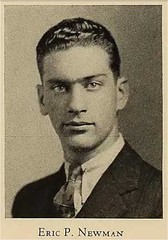 Thanks, Heritage, for the ice cream and birthday cake.
Thanks, Heritage, for the ice cream and birthday cake.
We appreciate the bids you all may make.
Perhaps this will help you to stay awake
Even though there happens to be no fake.
And thanks for your singing and celebration
To a numismatist so long in circulation.
Len also provided this photo from the 1931 MIT yearbook, Eric's junior year. Thanks!
ANS Executive Director Ute Wartenberg writes:
Happy Birthday to our beloved Honorary Trustee Eric Newman from everyone at the American Numismatic Society!
Ute adds:
The most amazing thing is that Eric is supposedly still not our oldest member...
Dave Bowers writes:
It has been my privilege and honor to have known Eric Newman ever since I was a teenager. In the intervening years we have visited many times and interfaced on so many writing and research projects that they cannot be counted. He is truly a national numismatic treasure!
Ray Williams writes:
On behalf of the Colonial Coin Collectors Club, I want to congratulate you on your 103rd Birthday. Thank you for the many decades you have dedicated to numismatic research and writing. We look forward to your future publications, but put research to the side today and enjoy the company of family and friends that gather to celebrate with you.
Ray adds:
On March 18th, 2001, I emailed Eric looking for a "donated lot" for the C4 Auction in November. I asked if he would be willing to sign a copy of The Early Paper Money of America on his actual 100th Birthday. His reply was:
Dear Ray:
Only you would think up an idea like signing something on a specific date in the future. I will be glad to cooperate if you will guarantee that I will live and be able to do so. I realize that I would mess it up if I did it in advance. Perhaps that after that date I would ask a congressman to certify that the book was signed on the date requested. Then there could be an argument about which signature was more worthless. There is no need to send me the book as I will be glad to furnish one. If I sign more than one on the proper date and send them to you would that give the matter more publicity.
What I need is the exact language you think would be most appropriate to raise the most for C 4.
Thanks for giving me something to look forward to. Looking forward to your 100th birthday and expect you to write me how you are doing, as still president of C-4.
I had replied to Eric that signing just one book on that date would make it very special. It was auctioned at our November C4 Convention in Boston, where a good friend obtained it with a generous donation. It now resides in a private library in Philadelphia where it is truly appreciated.
Ken Bressett writes:
Happy Birthday Eric. You have added immensely to our enjoyment and knowledge of numismatics. I have been blessed to have you as both friend and mentor for so many years.
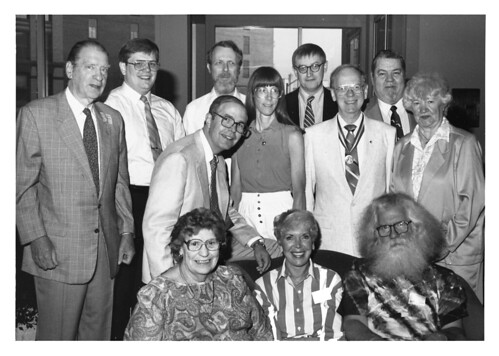
Ken attached this Rittenhouse Society photo with Eric standing at left. It's undated. That's Ken in the white jacket at right next to Margo Russell of Coin World. Here's the full list, courtesy of Ken:
Top row, left to right: Eric Newman; Craig Whitford; Bob Julian; Mike Hodder; Grover Criswell.
Center left to right: Q .David Bowers; (his wife) Christie Bowers; Ken Bressett; Margo Russell.
Seated: Bert Bressett (my wife); Marilyn Fivaz (Bill Fivaz’s wife – he must have taken the picture); and of course the hairy one is Walter Breen.
John Dannreuther writes:
I know how much Eric likes the rhyme,
So I thought I would give it a shot this time.
Collecting some of the coolest coins was his quest
As Yoda would say, an opportune time, we know the rest.
So here's to you, ya young old man,
103 is in the can.
May there be many more, Happy Birthday!!
Dick Johnson writes:
Eric, your numismatic books will live forever, let's hope you can create many more.
A fond memory for me is your visits to my off-campus apartment an 1954 when I was attending Washington University in St. Louis. The furniture was sparse, but I had my complete numismatic library in the apartment. We spent hours poring over numismatic books together.. A delight then and a delight to now recall this 60 years later.
Your more than a dozen published numismatic books have made a great contribution to numismatic literature. Your name will live forever in numismatic journals.
David Sundman writes:
As famed numismatist Eric P. Newman turns 103 this month, it is nice to reflect on how he has helped so many people for so many years in our own numismatic pursuits. My first encounter with Eric P. Newman was in book form, acquiring and using the first edition (1967) of his groundbreaking work, The Early Paper Money of America as a reference. Now I use the 5th edition, and await the 6th that Eric is working on.
I had met Eric P. Newman once at a coin show sometime in the mid-1980s, but I was still surprised to receive a letter from him in late October of 1986: Your advertisement in Stereo World stunned me because I did not know anyone else was sincere in collecting stereo views of mints and the bureau. I knew others must collect that sort of material, but I am glad to know that you do…. I do have a duplicate or so which I would be delighted to trade for something I do not have….
I took him up on his offer to trade duplicate views. This shared interest led to a series of exchanges, usually by mail, to our mutual benefit. Eric and I traded numismatic themed stereoview duplicates back and forth. He also traded me some wonderful Harper’s Weekly, and Leslie’s political cartoons revolving around monetary issues, from the 1860s to early 1900s, as well as western mining wood cuts and articles from various periodicals. I could never buy anything from him, there always had to be a trade, as he was “non-commercial.” All of this was great fun, and reminiscent of my old baseball card trading days with school chums in my youth. Every time we’d meet at various numismatic events, he and I’d check to see if there were any duplicates available for a trade.
More recently I’ve corresponded with Eric usually by e-mail regarding Colonial U.S. currency, and New Hampshire colonial in particular. He has never hesitated to share his knowledge, and give encouragement.
Eric P. Newman is a national treasure, and continues to share his enthusiasm for all things numismatic with everyone he meets. He is an inspiration. Happy Birthday, Eric!
David enclosed a photo of himself with Eric taken at his newly opened Newman Money Museum, the occasion being a seminar on paper money that he sponsored that day.
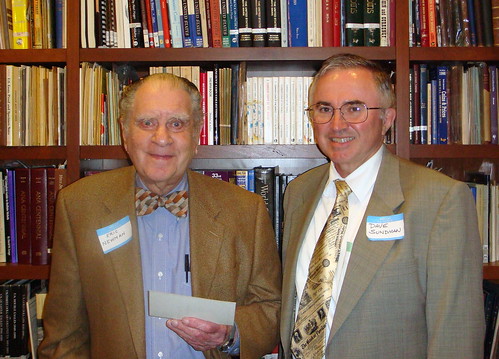
Eric Newman and David Sundman, May 10, 2008
Andy Newman writes:
Eric and Evelyn enjoyed Eric’s 103rd birthday today, eating his favorite foods (and ice cream, of course) and opening a pile of thoughtful cards and packages, many from the numismatic community. We’re extending the celebration to tomorrow when we’ll go out to a big family buffet. Life is good.
ERIC NEWMAN'S CENTURY OF LEARNING
 In 1918, when he was 7, Eric P. Newman’s grandfather gave him a strange old penny.
In 1918, when he was 7, Eric P. Newman’s grandfather gave him a strange old penny.
In the nearly 10 decades since, the passion for coin collecting ignited by that gift turned Mr. Newman into one of the hobby’s most respected figures and a leading authority on the art and history of American money. Beginning last year, Mr. Newman — who, at 102, is still researching and writing on the hobby — began selling some of the prized items from his collection to benefit a foundation he established to promote scholarship on coins.
“He belongs to that tradition which barely exists today,” said Ute Wartenberg, the executive director of the American Numismatic Society in New York, comparing Mr. Newman’s trove to the old-time cabinets of storied collectors like J. P. Morgan.
The penny that started it all for Mr. Newman was a copper-nickel Indian Head cent minted in 1859, when the government was experimenting with different metals before settling on bronze. In due course, he would find other pennies, with different dates, in his change.
“This fascinated me,” Mr. Newman wrote in an email last year. He began taking a streetcar to a coin store in downtown St. Louis.
“The round trip student fare was 3 cents. My allowance was 5 cents per week. I had to save enough to go downtown to buy a coin or so,” he recalled.
The owner of that coin store was a man named Burdette G. Johnson. “On one visit to his store he refused to sell me the coin I selected because I knew nothing about it,” recalled Mr. Newman.
“But if I would take home a book he would lend me and recite the coin’s history on my next visit, he would sell it to me.” This became a habit, with the coin dealer mentoring the young Mr. Newman as his knowledge grew.
“The key thing about Mr. Newman is the breadth of his knowledge,” Ms. Wartenberg said. “He is not only a collector but a writer.” He has more than 100 books and articles to his credit, and he has been awarded the highest honor among academic numismatists, which is rare for a collector.
Among Mr. Newman’s other great acquisitions was a collection of Colonial paper money, whose owner sold it to him in the 1950s “to encourage me to write an all-encompassing book on early American paper money, which I eventually did.”
“The Early Paper Money of America” was first published in 1967 and is considered one of the definitive works on the subject. Mr. Newman is working on its sixth edition.
Explaining his attraction to coins, Mr. Newman said they offered a “wonderful window into history and other fields for me. Numismatics involves economics, politics, geography, metallurgy and art.”
“Many collectors can tell you some of the narrative behind their coins,” Ms. Wartenberg said. “But Eric discovered the narrative.”
To read the complete article, see: In Coins, Man Found a Century of Learning (www.nytimes.com/2014/05/19/us/in-coins-man-found-a-century-of-learning.html)
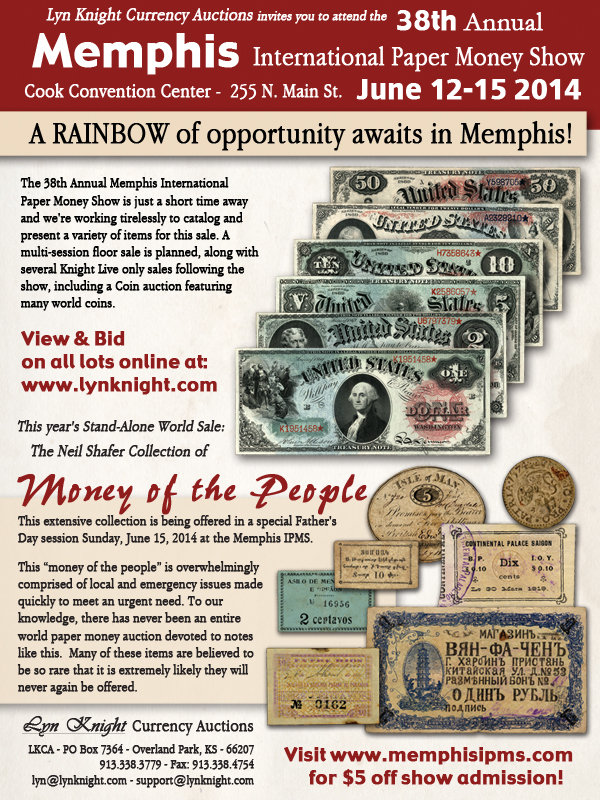
KOLBE-FANNING SALES 134-135 PRICES REALIZED
Kolbe & Fanning’s 134th and 135th sales of important numismatic literature from the libraries of Philip W. Ralls and others were held on May 15-16. The sales featured significant works in virtually all areas of numismatic study, most especially United States auction catalogues and large cent literature. The combined prices realized list may be seen on the firm’s website at www.numislit.com. Some highlights from the Phil Ralls library sale included:
 Lot 77, Wayte Raymond’s deluxe leather copy of George H. Clapp’s United States Cents of the Years 1798–1799, sold for $8500 (all prices herein are hammer prices).
Lot 77, Wayte Raymond’s deluxe leather copy of George H. Clapp’s United States Cents of the Years 1798–1799, sold for $8500 (all prices herein are hammer prices).
Lot 193, the deluxe leather copy of Howard R. Newcomb’s United States Cents of the Years 1801–1802–1803, sold for $6000.
Lot 181, a rare deluxe leather copy of the William C. Atwater catalogue (Mehl, 1946), sold for $4000.
Lot 65, a copy of Henry Chapman’s important catalogue of the Andrew C. Zabriskie collection, with original plates, sold for $2750.
Lot 64, a post-sale plated Stickney catalogue (Henry Chapman, 1907), sold for $2500.
Lot 83, an attractively bound original copy of Crosby’s Early Coins of America, sold for $2500.
Highlights from the second sale included:
 Lot 1060, a set of the Numismatische Zeitschrift complete up through the 1970s, sold for $6000.
Lot 1060, a set of the Numismatische Zeitschrift complete up through the 1970s, sold for $6000.
Lot 1180, a set of both Hess sales of the Dubletten Russischer Museen, sold for $1900.
Lot 1122, a lovely set of a rare two-volume 1760 work on coining, sold for $1700.
The two-day sale marked our introduction of live online bidding through icollector.com as an additional bidding method. The new bidding option brought in a number of new bidders and made the event more exciting for all concerned. We will continue to improve our online capabilities as well as accept bids the old fashioned way.
For more information, please see Kolbe & Fanning’s website at www.numislit.com.
Kolbe & Fanning Numismatic Booksellers LLC
141 W. Johnstown Rd.
Gahanna, OH 43230
(614) 414-0855
Cell (614) 256-8915
Fax (614) 414-0860
df@numislit.com
www.numislit.com
Members ANA, ANS, IAPN
SKLOW MAIL BID SALE #22 REMINDER
 Enjoy Memorial Day!
Best wishes to those that served, both on and off the fields of battle.
Enjoy Memorial Day!
Best wishes to those that served, both on and off the fields of battle.
If you have not submitted your bids for MBS # 22 closing Saturday June 7th at 8 PM MT, there are two weeks left to do so, if you have, thank you!
The auction has a fine run of early ANA Convention auction catalogs 1907-1952, including the extremely rare 1917. All three of the deluxe B. Max Mehl catalogs are also offered. Many runs of other catalogs, a complete set of the Numismatic Scrapbook, numerous reference works, and much more, with a few surprises! If you have misplaced your copy, the catalog is online at our web site for viewing or downloading.
Bidding is available via mail, phone, fax and email. Bid early and bid often! Have a very happy holiday weekend.
David Sklow-Fine Numismatic Books
P.O. Box 6321
Colorado Springs, CO 80934
PH: 719-302-5686
FAX: 719-302-4933
Email: numismaticbooks@aol.com
Web Site: FineNumismaticBooks.com
To read an earlier E-Sylum article with more details, see: SKLOW MAIL BID SALE #22 CLOSES JUNE 7, 2014 (www.coinbooks.org/esylum_v17n21a02.html)
KUENKER ELIVE AUCTION 29
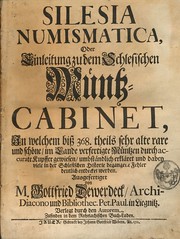 From the 19th of May to the 17th and 18th of June 2014 our eLive Auction 29 takes place on
www.elive-auction.de
.
You’ll find more than 1.500 lots of numismatic literature about subjects from ancient to modern times with some rarities among them.
From the 19th of May to the 17th and 18th of June 2014 our eLive Auction 29 takes place on
www.elive-auction.de
.
You’ll find more than 1.500 lots of numismatic literature about subjects from ancient to modern times with some rarities among them.
After the successful sale of the Herbert Kreindler Library in cooperation with Kolbe & Fanning we are proud to present another auction with numismatic literature. And again, this library has its focus on ancient numismatics. You will find more than 1,500 lot numbers with many rarely offered works.
We wish you a lot of pleasure with this auction and hope you will find a few additional items for your library! Take a closer look into our new eLive Auction right now!
Pre-bidding:
19.05.2014
Live auction starting date:
17./18.06.2014 – 5 pm
Fritz Rudolf Kuenker GmbH & Co. KG
Gutenbergstrasse 23
49076 Osnabrueck
Germany
Tel: +49-(0)541-962020
Fax: +49-(0)541-9620222
www.kuenker.de
NEW BOOK: THE INCONSPICUOUS GOLD RUSH MINT
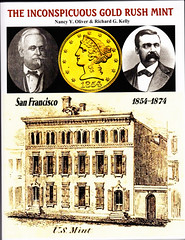 Most people have forgotten, or have never heard, that the most important mint of the California Gold Rush period was on Commercial Street in the city of San Francisco. Often when the Old Mint of San Francisco is discussed, thoughts turn to the still extant, magnificent structure, that is the second mint on Mission and Fifth Streets. However, despite having a homely face, the Commercial Street Mint was a very efficient and quite interesting coin factory. Thus the title of our new book, “The Inconspicuous Gold Rush Mint”.
Most people have forgotten, or have never heard, that the most important mint of the California Gold Rush period was on Commercial Street in the city of San Francisco. Often when the Old Mint of San Francisco is discussed, thoughts turn to the still extant, magnificent structure, that is the second mint on Mission and Fifth Streets. However, despite having a homely face, the Commercial Street Mint was a very efficient and quite interesting coin factory. Thus the title of our new book, “The Inconspicuous Gold Rush Mint”.
The word “inconspicuous” means something not readily noticeable, or not prominent or striking. It is our belief that this descriptive term fits appropriately for this mint. The building was never thought of as an architectural masterpiece, thus it is quite possible that no photographs were ever taken of it; however, the authors did discover an excellent lithograph of the building which graces the cover of the book.
This is the only book that provides a complete history of the first federal mint of San Francisco, in operation from 1854 until 1874. Five years in the making, this new book contains never before published items of historical interest, i.e. a report of a mysterious, and unknown, so-called ‘fancy coin’ struck during the opening ceremonies on April 1st, 1854, and new information on the ‘real culprit’ of the 1857 theft of gold bullion. It includes historical background information concerning the California Gold Rush period, which determined the need for a mint in San Francisco.
The book contains many unpublished images relevant to the times. Coin rarities, production, employee incidents, and die deliveries are also included. At the end of the book is an alphabetical list of the names of 611 employees discovered to have worked at this mint during its twenty years of operation - you will not find a more complete list of mint employees anywhere else.
The book is softbound, 142 pages in length, and heavily illustrated throughout. Numismatic Researchers/Authors Nancy Oliver and Richard Kelly are offering a 15% discount for E-Sylum readers who are interested in purchasing their newest work. With that discount, the book costs $20, and the authors will pay the postage. If you would like your book signed by both authors, please mention this in your response. Please send a check or money order made out to:
Richard G. Kelly
26746 Contessa St.
Hayward, CA 94545-3150
NEW BOOK: GUIDE BOOK OF U.S. PAPER MONEY, 4TH EDITION
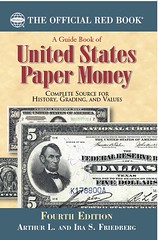 (Atlanta, Georgia) — Building on the scope of Robert Friedberg’s groundbreaking research, the Guide Book of United States Paper Money, fourth edition, is an engaging history and price guide of the paper currency of the United States. The full-color, 416-page book is available for $24.95 online (including at WhitmanBooks.com) and from booksellers and hobby retailers nationwide.
(Atlanta, Georgia) — Building on the scope of Robert Friedberg’s groundbreaking research, the Guide Book of United States Paper Money, fourth edition, is an engaging history and price guide of the paper currency of the United States. The full-color, 416-page book is available for $24.95 online (including at WhitmanBooks.com) and from booksellers and hobby retailers nationwide.
The Guide Book describes in detail every federal note from the ultra-rare Demand Notes of 1861 to the lunch money in our wallets today. Fascinating narrative captures the romance and history of American paper money, and also explores recent developments in the hobby and market, including the latest Federal Reserve Notes up to the Series of 2009 $100. The book combines the hobby-standard Friedberg numbering system with retail values in multiple grades. It is illustrated with hundreds of high-resolution full-color images.
“The first three editions of the Guide Book of United States Paper Money were very popular with collectors and dealers,” said Whitman publisher Dennis Tucker. “We’ve seen a dramatic increase in interest in paper-money collecting since the first edition was published in 2005. New collectors are constantly joining the hobby, so we’ve designed the fourth edition for newcomers as well as longtime hobbyists.”
Authors Arthur and Ira Friedberg are well known in the numismatic world. They have been professional numismatists for more than 30 years. Both joined their father’s family firm, The Coin & Currency Institute, after college. Since then they have established themselves as award-winning authors, coin dealers, researchers, and numismatic consultants to numerous governments and organizations.
Chapters cover notes from $1 to $10,000; Fractional Currency; Treasure notes of the War of 1812; encased postage stamps; error notes; signatures on U.S. currency; uncut sheets; and other hobby topics. The book includes a glossary and a bibliography for further research.
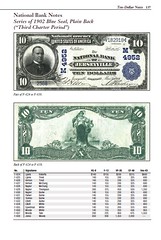 A Guide Book of United States Paper Money, 4th edition
A Guide Book of United States Paper Money, 4th edition
By Arthur and Ira Friedberg; introduction by David L. Ganz
ISBN 079484230-5
Full color, illustrated.
6 x 9 inches, softcover, 416 pages
Retail $24.95
For more information, or to order, see: www.whitman.com/store/Inventory/Detail/A-Guide-Book-of-United-States-Paper-Money-4th-Edition+0794842305
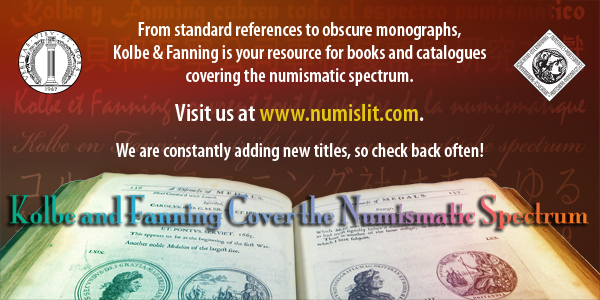
BOOK REVIEW: THE DOLLAR OF 1804
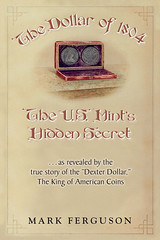 The Dollar of 1804: The U.S. Mint’s Hidden Secret (…as revealed by the true story of the “Dexter Dollar,” The King of American Coins), by Mark Ferguson.
The Dollar of 1804: The U.S. Mint’s Hidden Secret (…as revealed by the true story of the “Dexter Dollar,” The King of American Coins), by Mark Ferguson.
It’s hard reading Mark Ferguson’s book without thinking of Eric P. Newman and Kenneth Bressett’s The Fantastic 1804 Dollar (1962). Not only does every book concerning 1804 dollars have to answer, in some way, to that landmark work, but The Dollar of 1804: The U.S. Mint’s Hidden Secret feels like Ferguson’s direct response to it.
Where Fantastic succeeded was in its full-throated challenge to what was then orthodoxy regarding the coin’s origins. Before its publication, the 1804 dollar was a coin steeped in mystery and mythology, made ever murkier by dubious claims, accusations, and self-serving marketing. Newman and Bressett sought to cut through the hype surrounding the “King of American Coins” and assert, once and for all, that the coin was an imposter, by all evidence struck much later than its inscribed date. Every 1804 dollar, according to Newman and Bressett, was in fact, a coin of dubious origins.
Every 1804 dollar has a fascinating backstory. Of all of them, the Dexter dollar may be the most misunderstood.
Ever since the coin’s first known public offering in a German auction conducted by Adolph Weyl, the Dexter dollar has been the subject of scrutiny, suspicion, and slander.
Even Newman and Bressett got their digs in, alleging that its placement in the Weyl catalog was a conspiracy on the part of the Chapman Brothers to conceal its true origin by giving it a phony European pedigree.
Coin dealer and Chapman rival Edouard Frossard advanced a similar theory. He filled the pages of his publication Numisma with biting assertions that the coin was a restrike and that the Chapmans were perpetrating a fraud. Frossard looms large in the narrative and his mission to discredit the Chapmans plays a major role in the Dexter story.
Ferguson’s book makes pains to enlighten us with actual facts. For too long, the Dexter dollar has been shrouded in intrigue. How Weyl acquired the 1804 dollar remains unknown, Ferguson writes, but surviving correspondence between the Chapmans and Weyl unravel any alleged conspiracy that the two parties were working together to conceal the coin’s original source.
Ferguson is clearly at home with the material. His knowledge of the Dexter dollar is encyclopedic and he goes into great detail documenting the coin and its various owners, starting with James Vila Dexter. This information is interesting and vital to our understanding of the burgeoning coin industry of the 19th century.
To read the complete article, see: First Read: The Dollar of 1804: The U.S. Mint’s Hidden Secret (www.coinweek.com/numismatic-history/first-read-dollar-of-1804-u-s-mints-hidden-secret/)
READER THOUGHTS ON THE MARCH OF DIMES DESIGNS
Tom DeLorey writes:
I had not seen the proposed March of Dimes designs before. The first one, with the child walking away from the wheelchair, is unfortunately not appropriate. Having had polio myself before the vaccine was created, I can assure you that the research did not cure polio or its effects, though the vaccines it generated did blessedly prevent new cases of it.
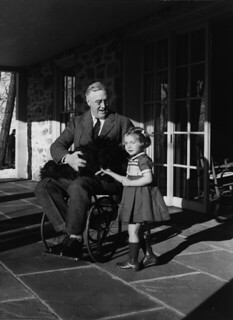 The image of FDR in his wheelchair is most appropriate, though I would rather see the similar image of FDR taken along with a young girl that I believe is representative of the many victims of infantile paralysis. It may represent the only time that FDR allowed himself to be photographed in his wheelchair, a noble concession he made to promote the cause. I do not like the image of the 1946 dime superimposed over the front wheel of the wheelchair, as it will cause some people to not recognize it as a wheelchair.
The image of FDR in his wheelchair is most appropriate, though I would rather see the similar image of FDR taken along with a young girl that I believe is representative of the many victims of infantile paralysis. It may represent the only time that FDR allowed himself to be photographed in his wheelchair, a noble concession he made to promote the cause. I do not like the image of the 1946 dime superimposed over the front wheel of the wheelchair, as it will cause some people to not recognize it as a wheelchair.
The other two designs do not do much for me, though the dual-headed one is not that bad. I would like to see the reverse image of the torch on the Roosevelt dime used somehow, as it was a subtle recognition of the "Mothers March Against Polio," also known as the "Torch Drive," because tens of thousands of mothers went out door to door collecting dimes from their neighbors for the cause. This was after dark because they had to feed their families first, of course, and they carried flashlights or "torches" to light their way.
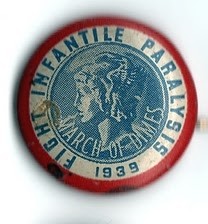 I have to agree with Tom. My choice was too hasty; the vaccine indeed only prevents the disease, it does not cure it. So while an empty wheelchair could symbolize children who didn't GET the disease, when shown together with a walking child a viewer could get the wrong impression. I knew better, but my commentary played into that view as well. Sorry!
I have to agree with Tom. My choice was too hasty; the vaccine indeed only prevents the disease, it does not cure it. So while an empty wheelchair could symbolize children who didn't GET the disease, when shown together with a walking child a viewer could get the wrong impression. I knew better, but my commentary played into that view as well. Sorry!
While searching for the Roosevelt photo, I found a related item, a 1939 March of Dimes button, pictured at right. -Editor
To read the complete article, see: Elizabeth Hayward Causes: March of Dime (theancestorfiles.blogspot.com/2010/11/elizabeth-hayward-causes-march-of-dimes.html)
Mel Wacks writes:
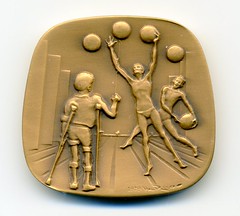 I still think that most new U.S. coin designs are banal, and that goes for most of those shown here. I would like to show the inspired reverse of the Jonas Salk medal that Hal Reed designed for the Jewish-American Hall of Fame back in 1980, that contrasts healthy children playing with balls and a polio victim holding a balloon, with the Salk Institute in the background. It is one of my favorite medal designs.
I still think that most new U.S. coin designs are banal, and that goes for most of those shown here. I would like to show the inspired reverse of the Jonas Salk medal that Hal Reed designed for the Jewish-American Hall of Fame back in 1980, that contrasts healthy children playing with balls and a polio victim holding a balloon, with the Salk Institute in the background. It is one of my favorite medal designs.
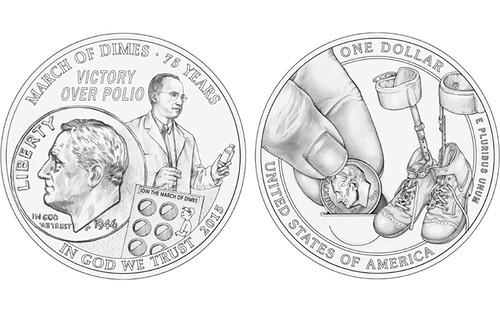
The review panel scrutinized 22 proposed obverse and 18 reverse designs.
The recommended obverse features the Roosevelt dime, Dr. Jonas Salk, and a dime board. Dr. Salk discovered the anti-polio vaccine and the dime board was used to collect contributions to the March of Dimes. The CFA recommended removing the dime board from the proposed obverse.
The recommended reverse features two fingers and a thumb grasping the edge of a 1946 Roosevelt dime to place it in a March of Dimes donation card. To the right is a pair of empty children’s polio braces. The large size of the fingers and card slot symbolizes the power of thousands who gave their pocket change to a good cause, according to the Mint, and the empty leg braces celebrate the victory over polio.
The CFA recommended removing the two fingers from the design and adding to the design the dime board panel mebmbers recommended be removed from the obverse.
The commemorative silver dollar, with a maximum authorization of 500,000 coins combined in Proof and Uncirculated versions, is authorized under provisions of the March of Dimes Commemorative Coin Act of 2012, Public Law 112-209.
To read the complete Coin World article, see:
Commission of Fine Arts recommends designs for 2015 March of Dimes commemorative silver dollar
(www.coinworld.com/news/2015-march-of-dimes-silver-dollar-designs-get-cfa-nod.html)
To read the earlier E-Sylum article, see:
MARCH OF DIMES COIN DESIGNS
(www.coinbooks.org/esylum_v17n21a22.html)
NOTES FROM E-SYLUM READERS: MAY 25, 2014
Buy the book (and Read It) Fred Michaelson writes:
Shouldn't that slogan be "Buy the book (and read it) before the coin" ?
A 'Grading Set' of Counterstamped Coins
In my earlier review of the Grading Guide for Early American Copper Coins, I wrote:
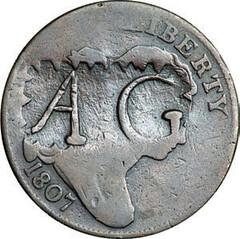
The Guide is not without humor, as exemplified by this illustration from p16 captioned, "While there are many ways to record a coin’s grade, this is definitely not the way to do it."
Fred Michaelson writes:
Do you know who owns the "AG" cent shown? It's really a coincidence that this issue arose, because I've been collecting "grade" counterstamps. I've got a P, an F, and a G. I bought what I thought was a VF, but it turned out to be WF. Every time I think of something wild and crazy, I find out somebody else thought of it, too.
To read the earlier E-Sylum article, see: BOOK REVIEW: GRADING GUIDE FOR EARLY AMERICAN COPPER (www.coinbooks.org/esylum_v17n19a07.html)
Henry Bergos and That Crazy Roman Salute
 Speaking of crazy ideas, I was struck by last week's picture of Henry Bergos and his classmates in the 1987 Ancient Roman Coinage seminar. I couldn't put my finger on why the image was stuck in my head until I realized how perfectly it expresses Henry's typical effect on people.
Speaking of crazy ideas, I was struck by last week's picture of Henry Bergos and his classmates in the 1987 Ancient Roman Coinage seminar. I couldn't put my finger on why the image was stuck in my head until I realized how perfectly it expresses Henry's typical effect on people.
It was the most natural thing in the world for him to tell everyone in the picture to do the Roman salute; in his mind it was obvious, and everyone should do it. Some of them thought, "I love it - it's crazy!" The rest of them thought, "I'm not doing that - it's crazy."
To read the earlier E-Sylum article, see: MORE ON HENRY BERGOS (www.coinbooks.org/esylum_v17n21a12.html)
More On Cataloguing Prison Scrip Paul Cunningham writes:
Some comments on the prison tokens and chits article. My interest was aroused because I had a close relationship with Jerry Zara and his book. Jerry was a simple man - he tried to catalog the tokens and stuff with a minimum of effort! He wanted his book to straightforward and easy to use. He would not approve of the rather complicated numbering system!
Regarding the pictured tokens - the first set is very scarce, the blue and beige tokens being on an order of ten to twenty times more scarce than those tokens in the second set.
And for the picky - the American VectUrist Association is so named because of the Greek (?) word vecture, standing for a "ride."
To read the earlier E-Sylum article, see: AN APPROACH FOR CATALOGUING PRISON SCRIP (www.coinbooks.org/esylum_v17n21a16.html)
Engineering Books, Books, Books
I like books. Most of the rooms in my home are covered with bookshelves, many of them floor to ceiling. Most of my books are nonfiction—I’m guessing over half of them are STEM-related.
For the edification of the few digital natives (anyone born with a smartphone in his or her crib) who may be reading this, let me briefly explain what a book is. It consists of a number of sheets of paper with writing or printing on them, fastened together along one edge, usually between protective covers. (I am not against “e-books”—I both read them and write them. But they are not books!)
Stephen Kahne, emeritus professor and former vice president of technical activities for IEEE, recently expressed his concern about the fate of “the once outstanding libraries of classic technical texts and reference books” that many of us own. “What are we going to do with them?” he asked.
Professor Kahne’s question, reinforced by a review of my own library, prompted me to search for possible recipients of classic engineering texts. Many public libraries no longer accept technical textbooks as additions to their holdings or even for resale at fundraisers. - See more at: http://www.todaysengineer.org/2014/May/backscatter.asp#sthash.Wv82rwxz.dpuf
To read the complete article, see: Books, Books, Books (www.todaysengineer.org/2014/May/backscatter.asp)
HANK BIECIUK AND THE RETAIL COIN DEALERS ASSOCIATION
 We're still low on information about the Retail Coin Dealers Association. A search for that organization came up blank in the library catalogs of the American Numismatic Association and American Numismatic Society.
We're still low on information about the Retail Coin Dealers Association. A search for that organization came up blank in the library catalogs of the American Numismatic Association and American Numismatic Society.
A search for Hank Bieciuk in the ANA library catalog reveals him as the author of the 1961 book, Texas Confederate County Notes and Private Scrip. A check in the ANS library catalog finds that reference plus an article titled Terminology for Obsolete Notes in the Winter 1963 issue of Paper Money.
A look in the online index of Paper Money yields more clues about Bieciuk. He was the first President of the Society of Paper Money Collectors, and also the first Editor of Paper Money (as noted in the January - February 2001 issue). Other entries describe him as a resident of Kilgore, Texas.
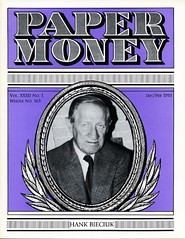 The January - February 1993 issue included a short obituary and he was pictured on the cover. But no mention is made of the Retail Coin Dealers Association. Bieciuk was employed full time in the graphics arts business. In 1961 he had come to the Altanta ANA convention to promote his new book on Texas notes. He was present at an organizational meeting of SPMC, and ended up getting drafted as President and Editor of the new club. An ad in the Fall, 1962 issue advertises "Hank Bieciuk, Inc." as "America's full-time obsolete currency dealer".
The January - February 1993 issue included a short obituary and he was pictured on the cover. But no mention is made of the Retail Coin Dealers Association. Bieciuk was employed full time in the graphics arts business. In 1961 he had come to the Altanta ANA convention to promote his new book on Texas notes. He was present at an organizational meeting of SPMC, and ended up getting drafted as President and Editor of the new club. An ad in the Fall, 1962 issue advertises "Hank Bieciuk, Inc." as "America's full-time obsolete currency dealer".
So by 1963 he was a full-time dealer and by 1964 he was involved with the Retail Coin Dealers Association. Perhaps he retired and started a second career in the numismatic world.
Dick Johnson writes:
The Retail Coin Dealers Association was founded, I assume, in 1959. The organizer lived in Dennison, Texas.
I pulled out four membership cards of this organization from my files. These were issued for 1960 through 1963. I was not a coin dealer but as editor of Coin World at the time I was made a charter member, with honorary membership #2.
The organization issued one or more membership lists in small pamphlet size. I remember its green paper cover, but cannot find it now in any pamphlet file. This would indicate the size of the organization and how wide was its acceptance in the field.
I believe the organizer lacked the organizational ability and national acceptance in the field, as did a Sol Kaplan or Dave Bowers of the later Professional Numismatists Guild (PNG).
While a short-lived organization, it was another brick in building of the commercial numismatic structure of today.
It's rare that E-Sylum readers get stumped on a numismatic question. Thanks, Dick! Perhaps one of those pamphlets or the convention program will turn up someday and shed more light on the organization and its membership.
To read the earlier E-Sylum article, see: MORE ON THE RETAIL COIN DEALERS ASSOCIATION (www.coinbooks.org/esylum_v17n21a18.html)
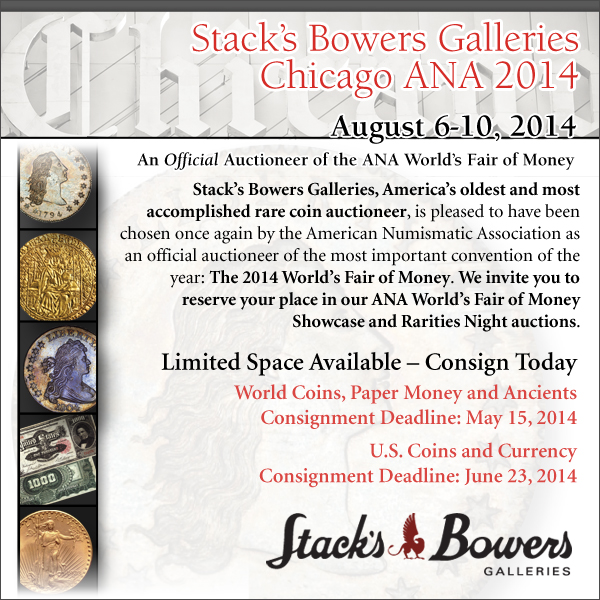
THE GEORGE KOLBE BOOKSELLER TOKEN
The George Kolbe bookseller token, shown with the May 18, 2014, issue of The E-Sylum, was originally included with Trade Tokens of British and American Booksellers & Bookmakers, published in 1989.
Henry Morris produced the book for Bird and Bull Press of Newtown, Pennsylvania. A bookseller provides this description, “8vo, quarter morocco. One of 300 copies of this edition, with an essay on tradesmen's tokens and their use from the seventeenth to the nineteenth centuries. With a checklist of known British tokens, and many illustrations and details. Quarter-bound in light blue morocco and printed paper, with a gilt-titled morocco label affixed to the spine. Housed in the publisher's slipcase with a portfolio of contemporary tokens struck for this volume.” The portfolio of contemporary tokens represented these companies:
-
 Bird & Bull Press
Bird & Bull Press
- The Book Press
- Dawson’s Book Shop
- Detering Book Gallery
- Enterprise Books
- Joseph J. Felcone
- Kater-Crafts Bookbinders
- George Frederick Kolbe / Fine Numismatic Books
- G. T. Mandl, English papermakers
- Iris Nevins, marbler
- Oak Knoll Books
Also included was one blank planchet (flan).
The dies were engraved by Kenneth Douglas at the Green Duck Company in Olive Branch, Mississippi. The tokens were struck under the supervision of Meyer Katz at the Unity Mint in Ambler, Pennsylvania. Morris reported that the dies cost $9800 in 1988. The set of used dies along with a mahogany box were offered for sale in 2006. The box included a metal plate engraved, “ORIGINAL DIES FOR BOOKSELLER’S TOKENS … BIRD AND BULL PRESS.”
Henry Morris began as a paper maker and printed his first book in 1958 as an outlet for his paper. The Bird and Bull Press combines high quality printing with high quality binding. They specialize in topics related to book production and paper making. Morris announced his retirement from the private press business in 2013 at the age of 88. A special exhibition of “The Life and Times of the Bird and Bull Press” was shown at the University of Delaware Library in 2013.
George Frederick Kolbe also included his bookseller token in copies for his 1990 44th sale catalog, “Selections from the American Numismatic Library of John Weston Adams.” The pages were die cut to fit around the token. Only 200 copies of the catalog were printed with the token included. Thus the token has an association, not only with Kolbe, but with Morris and Adams as well.
Some quantity of these tokens were not glued into a publication but were given out by Kolbe as promotional store cards and “good for” tokens after 1990. The Kolbe tokens show up occasionally on the secondary market. I can’t recall seeing the Bird and Bull token not attached to the book.
I was honored to work with Henry Morris on The Magnum Opus of Joseph Florimond Loubat, with 150 copies printed in 2007. This was a reprint of my 2006 article on Loubat for The Asylum. Also included were articles by John W. Adams and George F. Kolbe. The book was bound at Campbell-Logan Bindery in Minneapolis.
Henry Morris, Bird and Bull Press, John Weston Adams, George Frederick Kolbe and Campbell Logan Bindery all represent the highest accomplishments in their fields. When I see my name included in the credits, it is like entering an elite private club and expecting that security will escort me out at any moment.
To read the earlier E-Sylum article, see: 1988 GEORGE FREDERICK KOLBE GOOD-FOR TOKEN (www.coinbooks.org/esylum_v17n21a15.html)
QUERY: WHERE IS THE NEW ENGLAND STIVER?
Bob Van Arsdell writes:
The recent celebrations for Eric Newman have reminded me of an old episode from the late 1970s. I met a New Jersey vest pocket dealer named Dave Dokus, who owned the "New England Stiver". I saw the "Stiver" first hand.
The story was that Eric Newman had asked to see the coin, and had judged it to be a fantasy piece - evidently something having to do with the fabric of the flan. Yeoman was contacted, and the piece was eventually deleted from the Red Book.
The coin was from the Parmalee collection, was published by Crosby, and appeared in the first edition of the Red Book. A note "It is possible that this is a fantasy coin." was added to the listing in 1967 and in 1972, the listing was dropped entirely without further comment.
Although I'm not knowledgeable about the series, I don't recall ever seeing a formal condemnation of the piece. It seems a pity that such a potentially important object should simply disappear from the numismatic record without a publication recording the details.
The New England stiver is supposed to have originated in Holland to supply small change to Dutch merchants in New Amsterdam during the period of Dutch control 1623 64 and as in the case of the New Yorke token its circulation was probably very limited 2 A law supposedly directed in part against this token was passed by the Council and House of Representatives of Massachusetts March 21 1700 providing that in three months all tokens were to be redeemed at the highest rate for which they had passed and persons continuing to put out tokens were to be fined not exceeding 50 or be imprisoned not exceeding six months
To read the complete article, see:
THE USE OF PRIVATE TOKENS FOR MONEY IN THE UNITED STATES
(books.google.com/books?id=fzlEAAAAIAAJ&lpg=PA603&
ots=hGxZePSrf4&dq=%22New%20England%20Stiver%22&pg
=PA603#v=onepage&q=%22New%20England%20Stiver%22&f=false)
The unique NEW ENGLAND STIVER, the following description of which, from Mr. Mickley's Catalogue, embraces all that is has been conjectured concerning it:
"Obverse NEW ENGLAND. M. Reverse 1 S.V.C. Two lions, rudely executed, to Right and Left, in field of the coin. See Dickeson Plate XX No 14.
No one acquainted with the coins of Holland can hesitate for a moment as to the origin this: it differs in no respect in its general, in its general appearance and particular style of workmanship from the Dutch Stiver of Two hundred ago."
To read the complete article, see:
COIN AND COIN COLLECTORS - THE MICKLEY COLLECTION
(books.google.com/books?id=_qs_AQAAMAAJ&lpg=PA114&ot
s=AL2fPCJ9a8&dq=%22New%20England%20Stiver%22&
pg=PA114#v=onepage&q=%22New%20England%20Stiver%22&f=false)
 Lot 349: New England; Stiver; two lions or skins...believed to be unique; copper; very good (Crosby, p. 347, pl. VIII, No. 13); We think this token is of native manufacture and not Dutch, as Mr. Crosby suggests; as the workmanship, letters, &c. are in no way like the Dutch work, but strongly resemble the crude engraving of the Pine-tree money makers.
Lot 349: New England; Stiver; two lions or skins...believed to be unique; copper; very good (Crosby, p. 347, pl. VIII, No. 13); We think this token is of native manufacture and not Dutch, as Mr. Crosby suggests; as the workmanship, letters, &c. are in no way like the Dutch work, but strongly resemble the crude engraving of the Pine-tree money makers.
To read the discussion thread, see:
Numismatic History - Lorin G. Parmelee
(forums.collectors.com/messagepost.cfm?postaction=reply&catid=26&threadid=778334&messid=9803459
&STARTPAGE=3&ezquote=y&parentid=9803459)
THE BOOK BAZARRE
MORE ON THE SS CENTRAL AMERICA LITIGATION
I read last week’s section about the Central America litigation with great interest. The background provided for Milt Butterworth, Jr., left out an important fact - he is Tommy Thompson’s brother-in-law, being married to Tommy’s elder sister Sandee/Sandra Elaine Butterworth, née Thompson. That relationship is mentioned in the Forbes’ 2006 article, Ship of Fools.
Another good article, which I don't think has been linked yet in The E Sylum, is a June 2009 reprint of a June 1999 article in Columbus Monthly, Ship of Debt. Among the new things I learned was that Thompson had been married, and had three kids. Thompson’s wife and family aren’t mentioned at all in Gary Kinder’s Ship of Gold in the Deep Blue Sea.
The latest twist in the litigation sounds a lot like an odd bankruptcy case that was brought in Delaware last year, in an apparent attempt to delay the receivership action in Ohio. Both Lorz and Robol, who were involved in the bankruptcy case, are involved in this one as well.
Here’s a link to the motion to dismiss in the bankruptcy case. It’s quite interesting on the procedural posture. Astonishingly, the bankruptcy petition was signed by one Jennifer Jones, who then turns out to be a made up person:
To read the complete article, see: Chapter 11 Case No. 13-10347 (PJW) (www.documentcloud.org/documents/624212-dismissal.html)
Another interesting tidbit is provided by Williamson v. Recovery Ltd Partnership, 542 F.3d 43 (2d Cir. 2008), which has this remarkable statement: “Defendants, on the other hand, argue that, while gold and valuables were certainly found on the ship, the recovery efforts did not actually provide a return to the initial investors, much less a profit, and that Defendants therefore have not violated their contract with Plaintiffs.” In other words, the entire Central America venture - with all that gold - ended up losing money.
Last month, with the approval of an Ohio judge, deep-sea divers with Tampa, Fla.-based Odyssey Marine Exploration returned to the shipwreck and began recovering gold under a contract with the court-appointed receiver over Thompson’s former company, Recovery Limited Partnership.
Columbus-America and its current president, Milt Butterworth, are now fighting to gain control over any recently recovered gold, stop the expedition and conduct any future trips to recover the gold.
Late last week, federal Judge Rebecca Beach Smith declined to rule which company has the rights to the sunken ship but did find that Odyssey Marine “is qualified to perform the ongoing salvage operation,” ordering that it can continue doing so.
It’s unclear when she’ll issue a ruling about who has rights to the sunken treasure.
To read the complete Forbes article, see: Ship Of Fools (www.forbes.com/forbes/2006/0619/158.html)
To read the complete Columbus Monthly article, see: Ship of debt (www.columbusmonthly.com/content/stories/2009/06/ship-of-debt.html)
To read the complete Wall Street Journal bankruptcy article, see:
Investors Want to Sink Columbus Exploration Bankruptcy
(blogs.wsj.com/bankruptcy/2013/03/18/investors-want
-to-sink-columbus-exploration-bankruptcy/)
To read the complete Williamson v. Recovery appeal, see:
Williamson v. Recovery Ltd. Partnership, 542 F. 3d 43 - Court of Appeals, 2nd Circuit 2008
(scholar.google.com/scholar_case?
case=538076350304690631&hl=en
&as_sdt=6&as_vis=1&oi=scholarr)
To read the Columbus Dispatch article, see: Fugitive’s company wants control of treasure site (www.dispatch.com/content/stories/local/2014/05/18/fugitives-company-wants-control-of-treasure-site.html)
To read the earlier E-Sylum article, see: COLUMBUS-AMERICA GROUP SUES ODYSSEY (www.coinbooks.org/esylum_v17n21a10.html)
1812 ISLE OF MAN 5 SHILLINGS CARDBOARD NOTE
 Oval; 70 x 56mm. Part of the series of "Card Money" issued in the Isle of Man during early years of the 19th century. Value on face, sailing ship on back with inscription around. Purchased at least 25 years ago from well-known Michigan collector Richard J. Ford as "possibly unique" at a price of nearly $1000. I have never seen or heard of another, before or since. Surface on face shows signs of handling but overall preservation is excellent, especially on back. This piece should see spirited bidding for many reasons.
Oval; 70 x 56mm. Part of the series of "Card Money" issued in the Isle of Man during early years of the 19th century. Value on face, sailing ship on back with inscription around. Purchased at least 25 years ago from well-known Michigan collector Richard J. Ford as "possibly unique" at a price of nearly $1000. I have never seen or heard of another, before or since. Surface on face shows signs of handling but overall preservation is excellent, especially on back. This piece should see spirited bidding for many reasons.
To read the complete lot description, see: NL 5 Shillings 2.1.1812 (www.lynknight.com/ShowAuctionDetails.Asp?auction_Id=222691)
Neil Shafer adds:
Pam West, Britain's leading banknote dealer, wrote to my son Joel and informed him that with all the research she and others have done to prepare for a forthcoming book on Isle of Man paper money, no one has ever seen or heard of this piece before. In other words, as far as anyone knows it really is unique - a true discovery piece, something very rare in the well-researched British Commonwealth realm. Pam asked for a scan for use in the book.
To read the earlier E-Sylum article, see: BINI BOOK OF 1891 CHILEAN REVOLUTION NOTES (www.coinbooks.org/esylum_v17n21a26.html)
1863 HAITIAN "COW ISLAND" NOTE
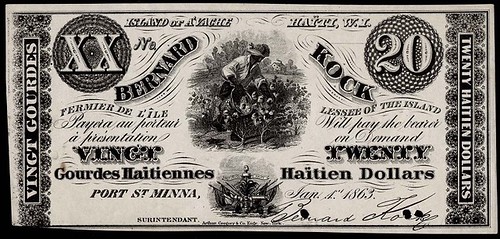
Proof in black and white; punch canceled. 182 x 76mm. Cotton being picked. This is one of the strangest issues made as a result of the US Civil War. Bernard Kock, opportunist and entrepreneur, wanted to colonize Ile A'Vache (Cow Island), Ha ti with 5,000 freed American slaves. With Lincoln's assistance, Kock started his venture in 1863. But without critical funding from his backers, the colony never fully materialized; Kock was "left out to dry." He had noble plans of building a community with profit sharing for the slaves. The Haitian government had promised citizenship to the participants but that also never happened. Kock's currency, without backing, could be used only at his company stores.
Ile A'Vache folded in December 1863 when Kock's financial partners abandoned their interest. On Dec. 22, President Lincoln sent a ship to bring the remaining slaves back to the US, thus canceling any future colonization plans. Small tape on plain back; couple tiny brown spots; close lower left corner margin. Sharply printed and very attractive, a true West Indies rarity. Two examples of lower denominations brought $2700 each at auction twelve years ago.
To read the complete lot description, see: NL 20 Haitien Gourdes/Dollars 1.1.1863 (www.lynknight.com/ShowAuctionDetails.Asp?auction_Id=222689)
THE KWEICHOW BAMBOO DOLLAR
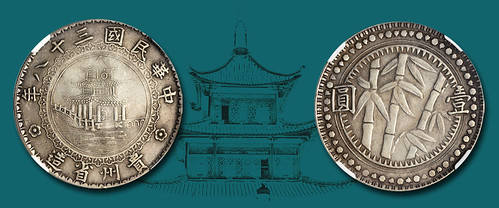
For this week’s August Hong Kong Showcase Auction preview Stack’s Bowers and Ponterio presents a classic Chinese numismatic rarity -- the famous “Bamboo Dollar” from Kweichow Province. According to Kann, this “dollar” was issued as rampant inflation in the 1940s devalued paper currency in China leading some provinces to begin minting their own metallic money. Minted in the “38th year of the Republic” (1949) this coin shows an incredible level of artistry and does not seem to have entered circulation, remaining as an essay piece. The scarcity of this piece can be partially attributed to the historical events unfolding around the time period. In the late 1940s the Chinese Civil War resumed, with the communist forces controlling Beijing and other major Kuomintang cities came under Communist control.
As these were minted during this tumultuous period (under the Republican government), these republican coinage designs were most likely buried (leading to often seen corrosion on this issue), hidden away in stashes (providing excellent collectible examples) or simply destroyed by the communist government and repurposed. As such, this coinage type from the twilight of the mainland Republic of China is a scarce type and with its beautiful design stands among the classic Chinese numismatic rarities.
The obverse design contains a stunning image of an iconic three story Chinese pavilion known as the Jiaxiu Tower (First Scholar’s Tower). The name Jiaxiu hails from the Ming dynasty era when the tower was built and means “getting the very best in Imperial examinations”. The building was a place to live and study for these “number one scholars”, and records indicate that three such officials honored the city by residing there. Standing at 66 feet high the tower is adorned with green tiles, red pillars, artistically engraved windows and stunning white stone parapets. This architectural marvel sits atop the Fuyu Bridge over the Nanming River, and casts a wonderful reflection in the water (especially at night when hundreds of lanterns are lit). A single Chinese character (Kuo) is found on the door to the pavilion, which refers to the then governor of the province, Kuo Tseng Kuang. The initials “TLK” appear just below the door of the pavilion and are speculated to refer to the engraver of the coin.
Two varieties exist for this “Bamboo Dollar”, and are identified by the window in the top story, with this being the “round window” variety. An ornate border surrounds the Jiaxiu Tower on bridge design, with descriptive legends around. The upper legend states: “38th Year of the Republic of China” which means the year 1949. Beautiful rosettes separate the upper legend from the lower legend which states: “Made in Kweichow Province”. The reverse design offers this coin its informal title of “Bamboo Dollar”; three stems of bamboo with leaves are encompassed by a saw-tooth border, followed by a beaded border and finally a crenulated outer border. The Chinese characters for “One Dollar” appear at either side of the Bamboo image.
To read the complete article, see:
Rare and Beautiful Kweichow “Bamboo Dollar”
(www.stacksbowers.com/NewsMedia/Blogs/TabId/780/ArtMID
/2678/ArticleID/64523/Rare-and-beautiful-Kweichow-)
THE BOOK BAZARRE
QUERY: '1915' HUDSON BAY COMPANY TOKEN

The above photo is of one of the items consigned to my next mail bid sale coming up in September. Although the incused lettering style is very much like other known Hudson Bay Company tokens, this specific one does not appear to have been discovered previously. It is made of aluminum (like other known HBC tokens), all inscriptions are incuse, and the size is 32mm.
The obverse is very well done, and appears genuine enough. The stamping on the reverse, however, seems to have been done by hand. I just wonder if that 1915 stamping could somehow relate to this event. I’ve tried many different sources and contacted other collectors for information but have not found anything else.
in 1915, the Hudson’s Bay Company closed, for good, its old “Fort George” trading post near the junction of the Fraser and Nechako Rivers. A fixture in the area for almost 110 years, the post was a catalyst behind the eventual development of the Prince George area. Its four walls stood witness to a century’s worth of history as northern British Columbia slowly opened to the outside world.
The Fort George post was originally established in 1807 by explorer Simon Fraser as he charted fur trade routes for the North West Company. Named after King George III (the reigning monarch of the time), the post remained largely isolated and unchanged for almost 100 years, its officers quietly serving the stream of hardy trappers, traders, natives, prospectors, outfitters, settlers and other parties who passed through the area.
By the end of 1914, the railway was up and running and the new townsite of Prince George was growing by leaps and bounds. With the fur trade dwindling, water-based travel declining, and the Hudson’s Bay Company channelling resources into its growing chain of department stores, Company officials decided to pull the plug on the old Fort George trading post.
To read the complete article, see: April 10, 1915 – Fort George trading post closes doors after over a century of service (facesplacesnorth.wordpress.com/2014/04/10/april-10-1915-fort-george-trading-post-closes-doors-after-over-a-century-of-service/)
STUDENT SPENDS "MOE MONEY"
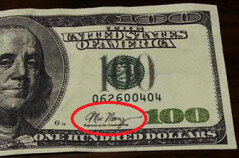 Campus police with the University of North Carolina at Greensboro have charged a student in connection with counterfeit currency.
Campus police with the University of North Carolina at Greensboro have charged a student in connection with counterfeit currency.
Symone Vannessa Brown, 19, of Charlotte, was charged with one count each of uttering a forged instrument, forgery of instrument and obtaining property by false pretense.
Brown allegedly attempted to buy a gift card at the Walgreens on Spring Garden Street with a counterfeit $100 bill, which ultimately led to the arrest.
UNCG police said $12,882 of counterfeit currency was seized following Brown’s arrest on Tuesday.
Close inspection of one of the counterfeit $100 bills showed the signature on the bill as “Moe Money.”
To read the complete article, see: UNCG student arrested for counterfeit currency (myfox8.com/2014/01/22/uncg-student-arrested-for-counterfeit-currency/)
GAMES AND FESTIVALS ON ROMAN COINS
Small Change Big Games is a project that will explore images of games and festivals on Roman coins in The Hunterian’s collection.
Roman games
 Wild beast hunts and gladiators fighting to the death aren’t events we expect to see at the Commonwealth Games, but they were always popular at the Roman games. The Romans might have had a different idea of entertainment, but there are still plenty of similarities between Roman games and those happening today.
Wild beast hunts and gladiators fighting to the death aren’t events we expect to see at the Commonwealth Games, but they were always popular at the Roman games. The Romans might have had a different idea of entertainment, but there are still plenty of similarities between Roman games and those happening today.
The Roman games were celebrated several times each year and entertained the Roman people in the same way for centuries. They were public holidays (like Bank Holidays in the UK) that were first and foremost religious celebrations, and they came with entertainments paid for by the state.
As well as the wild beasts and gladiators, these entertainments included theatrical shows and chariot racing!
Religion
 Can you see the altar and the people around it giving offerings? This is a sacrifice, watched by a goddess on the left and a sacrificial animal on the right. What does it all mean, and where did it fit into the games?
Can you see the altar and the people around it giving offerings? This is a sacrifice, watched by a goddess on the left and a sacrificial animal on the right. What does it all mean, and where did it fit into the games?
Politics
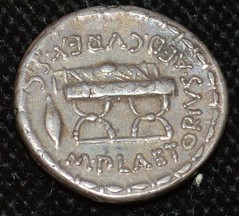 What is a magistrate’s chair doing on a coin? Well, this magistrate organised the games - and he wants you to know about it so you’ll vote for him!
What is a magistrate’s chair doing on a coin? Well, this magistrate organised the games - and he wants you to know about it so you’ll vote for him!
History
 A wolf and two children - does this story sound familiar? It is part of Rome’s foundation myth - Romulus, Remus and the she-wolf.
A wolf and two children - does this story sound familiar? It is part of Rome’s foundation myth - Romulus, Remus and the she-wolf.
To visit the site, see:
Small Change Big Games
(smallchange2014.tumblr.com/)

HILL HENTSCHEL LITHOGRAPHIC INK TRADES SCRAPBOOK
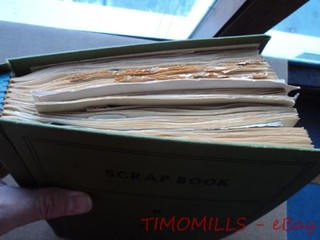
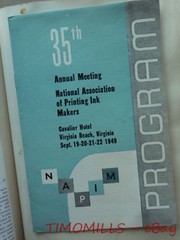
Kerry Rodgers writes:
As we all know, the legendary Ruth Hill collection is currently being sold by Heritage. While browsing eBay the other day I came across this item: " 1940s Hill Hentschel Southern Printing Lithographic Ink Trades Scrapbook".
That was Adolph B. Hill Jr III’s ink company. The scrap book must have been assembled about the time Ruth was getting serious about notes. And we know it was her husband’s connection with sundry banks that helped get her hooked. Did he make and supply note/security printing inks among others?
The scrap book may interest an intrepid researcher.
To read the complete eBay lot description, see:
1940s Hill Hentschel Southern Printing Lithographic Ink Trades Scrapbook Vintage
(www.ebay.com/itm/1940s-Hill-Hentschel-Southern-Printing
-Lithographic-Ink-Trades-Scrapbook-Vintage/131119665439)
CAMPAIGN FOR TACTILE AUSTRALIAN BANKNOTES
 Australian banknotes may never feel the same again if 12 year-old Connor McLeod has his way.
Australian banknotes may never feel the same again if 12 year-old Connor McLeod has his way.
Connor, who is legally blind and his mother Ally Lancaster, have lodged a complaint with the Human Rights Commission against the Reserve Bank of Australia.
Taking their cue from landmark overseas cases, they say Australian banknotes discriminate against the 300,000 people with visual impairment because they lack tactile markings.
Australian notes differ in size, and are printed with large numbers that assist people with some visual impairment, but they are difficult to differentiate for many other people.
To tell notes apart, Connor uses a device called a test card, provided by the Reserve Bank.
But like most 12-year-olds, the Oakhurst, NSW, year 7 student hates to stand out from his peers.
''The cash test card is embarrassing to pull out,'' he said. ''If you take it out and others see, it is like, 'Yep, he is blind'.''
A petition by Ms Lancaster on Connor's behalf on change.org has attracted nearly 56,000 signatures of support.
Of the 180 countries that issue banknotes, only 23 use tactile markings such as raised dots, grooves or symbols.
The Reserve Bank, which is currently redesigning Australia's notes, said it was assessing a number of ways that tactile features could be incorporated.
To read the complete article, see: Mother and blind son campaign for tactile Australian banknotes (www.smh.com.au/national/mother-and-blind-son-campaign-for-tactile-australian-banknotes-20140524-38vmd.html)
THE BOOK BAZARRE
AUGMENTED REALITY FOR NUMISMATIC DISPLAYS
ANCIENT coin hoards displayed at Kendal Museum are set to be viewed by members of the public using 21st century technology.
The Station Road attraction has secured almost £7,000 in funding to brings cutting edge Augmented Reality (AR) technology into its galleries.
It will make Kendal one of the first museums in Cumbria to use AR, a type of virtual reality, meaning that the more fragile exhibits can be viewed electronically.
The £6,987 grant will go towards displaying seven coin hoards, ranging from Roman (AD253-274) to Tudor times (1553-1576).
The museum say allowing visitors to view the coins this way will mean they are able to reach a wider audience while visitors will be better able to engage with the museum’s collections.
“This technology will also enhance visitors’ experiences and help them to understand our heritage.”
Morag Clement, Archaeology Curator of Kendal Museum, said: “This is a fantastic opportunity for the museum to link 21st century technologies with Cumbrian heritage.
To read the complete article, see:
Virtual view boost for Kendal Museum's coin collection
(www.thewestmorlandgazette.co.uk/news/11226263.Virtual
_view_boost_for_Kendal_Museum_s_coin_collection/)
MOULD FOR COUNTERFEIT ROMAN COINS EXHIBITED
 For those who think financial fraud or circulating fake currencies is a modern day phenomenon, an ancient Roman coin mould on display at the Department of Archaeology, Museums and Heritage in the city is a startling revelation.
For those who think financial fraud or circulating fake currencies is a modern day phenomenon, an ancient Roman coin mould on display at the Department of Archaeology, Museums and Heritage in the city is a startling revelation.
The Roman coin mould, which is being displayed for the first time since its excavation in 1993, indicates that fake coins were in circulation around 19 to 20 centuries ago. The terracotta mould is among the most important objects displayed at the exhibition, apart from terracotta figurines, iron objects, bronze dies, stone beads.
M S Krishnamurthy, a retired professor of Archaeology who led the team that unearthed the mould, told Deccan Herald that it was a mould for Roman coins in circulation during the first century AD. “The coins probably were minted either during the period of Augustus or his son Tiberius,” he said.
“In the area where we spotted the mould, a foundry with a crucible was also found. Considering this, it is possible that a person living in Talkad was minting duplicate coins of Romans,” he said. He added that it was one of the rare and unique moulds excavated in the State.
Archaelogist Gowda N L said that the mould contained an inscription of Greek goddess Livia with words, ‘Maxim Pontis’.
He added that the coins might have been minted at Talkad and circulated around the country. “It is possible that the value of Roman currency was more in India during the period, which might have led a few individuals at Talkad to indulge in minting fake coins,” he added.
To read the complete article, see:
Mould for minting Roman coins found in Talkad
(www.deccanherald.com/content/408181/mould
-minting-roman-coins-found.html)
WHY MUSEUMS HATE ANCIENT COINS
 As collectors of ancient coins, one of the most Frequently Asked Questions we encounter is “Don’t these things belong in museums?” The answer, sometimes with a patient sigh, sometimes with a snort of derision, is an emphatic, “No!”
As collectors of ancient coins, one of the most Frequently Asked Questions we encounter is “Don’t these things belong in museums?” The answer, sometimes with a patient sigh, sometimes with a snort of derision, is an emphatic, “No!”
The Dirty Little Secret is that museums hate ancient coins. Or, to put it more accurately, most museum curators and officials would be happy not to have to deal with them.
Coins are usually two-sided. This means unless a museum owns two good examples of the same type, only one side is going to be visible, unless coins are mounted in front of a mirror or between sheets of glass in cases accessible from both sides. Another solution preferred by some curators is to provide high-resolution photographs of both sides alongside the coin.
Museums hate coins because coins are usually small. This makes them hard for visitors to see.
One might object that the Hope Diamond is also small – weighing nine grams (45.52 carats) and about 25mm wide. But crowds throng to view it at the Smithsonian Natural History Museum every day.
The diamond comes with a dramatic story about being “cursed,” and an estimated value of $200-$250 million; few coins can claim that kind of star power.
Which brings us to a third reason. If they’re valuable or made of precious metal, coins are a security headache for museums. In 2007, the American Numismatic Association Money Museum suffered the theft of 300 historically significant coins with a total value of nearly a million dollars. It was an inside job. Some have been recovered; some are still missing. Recently, when members of the Washington Ancient Numismatic Society visited the Smithsonian American History Museum to view a selection of rare ancients, we had an armed guard–as well as a curator–accompany us.
The Metropolitan Museum of Art in New York has what is probably the greatest collection of Etruscan artifacts outside of Italy: ceramics, carved gems and spectacular jewelry, weapons and armor, a complete bronze chariot… but not a single Etruscan coin on display.
This brings us to the crux of the matter. Compared to the spectacular crowd-pleasing artifacts that museums crave, ancient coins are unexciting.
I know these are heretical words for any coin geek to write. One of the greatest thrills of my life was actually holding a gold diobol of Athens – a coin made of gold stripped from the statues on the Acropolis when Athens faced financial ruin in 407/406 BCE (less than a dozen examples are known).
But a viewer unfamiliar with the history and the context might easily gaze upon such a treasure without a flicker of interest or delight.
To read the complete article, see: Why Museums Hate Ancient Coins (www.coinweek.com/commentary/museums-hate-ancient-coins/)
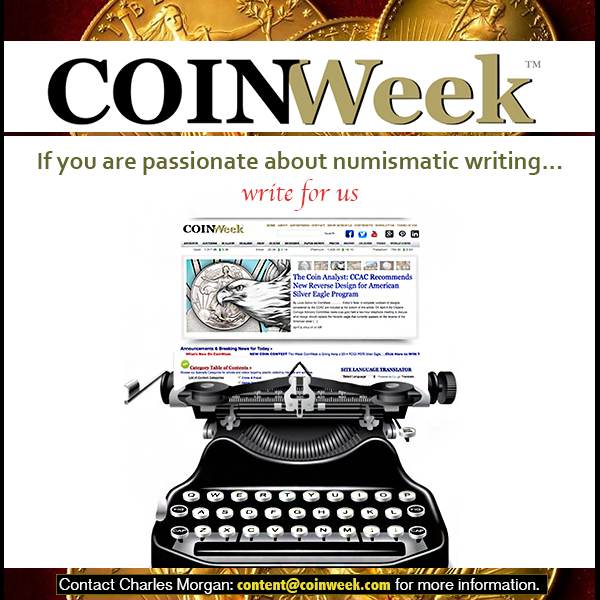
SILVER PENNY OF ÆTHELBERHT II FOUND BY METAL DETECTORIST
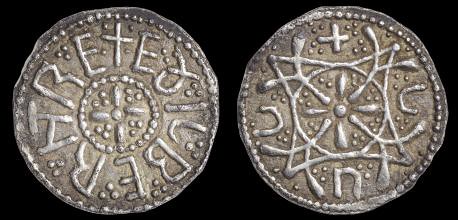
A metal detectorist has unearthed a unique Anglo-Saxon silver penny which sheds light on the murder of a king 1,200 years ago.
The 48-year-old contacted the Early Medieval Corpus of Coin Finds at the Fitzwilliam Museum in Cambridge and was told that the silver penny was the only one of its kind ever discovered.
Three others have been found from the reign of Æthelberht II, the late eighth century ruler of East Anglia, but this is the first to bear the title REX (“king”) on the same side as his name.
Æthelberht was king from 779 until 794 when Offa, the much more powerful king of neighbouring Mercia, invited him to his villa at Sutton Walls in Herefordshire to marry his daughter.
Offa had Æthelberht seized, bound and beheaded.
Until now there was no clue to his motive.
A spokesman for international coin and medal specialists Dix Noonan Webb said: “This find changes our knowledge of Anglo Saxon coinage. Saxon coins weren’t just used for day-to-day transactions, they were a way for rulers to project their image.
“If Offa thought Æthelberht was getting too big for his boots, that might be why he was so brutally murdered.”
According to legend, Æthelberht’s severed head later fell off a cart and rolled into a ditch.
After it was found it was said to have restored a blind man’s sight, resulting in the dead king being declared a saint.
The coin will be auctioned on June 11 at Dix Noonan Webb in London, when it is expected to fetch between £15,000 and £20,000.
To read the complete article, see:
Eastbourne man unearths Anglo-Saxon coin
(www.theargus.co.uk/news/11223559.1_200_year_old_coin
_sheds_light_on_a_king_s_murder/)
READING JAPANESE DATES
It requires only a few steps to learn how to read Japanese dates That is correct. You need to :
- recognize the year, month and day characters
- know how Japanese numbers are composed
- know about formal numbers
- understand the date system
- and read in the right direction.
The combination of each one of these skills seems to make the task tough. But each step is easy to learn. Stay with me all the way down. I'll guide you step by step through the process. At the end of this post I will congratulate you because you will have mastered a new skill : reading Japanese dates !
The year, month and day characters in the common date format The date 2014年04月30日 is written in the modern commonly used date format. It stands for April 30, 2014. The example shows that, together with Hindu-Arabic numerals, also Japanese characters are used. These characters stand for year, month and day, and it is important you can recognize them :
- year : 年
- month of year : 月
- day of month :日
In Japanese, the combination of this characters form the word 年月日 'date'.
To read the complete article, see: Reading Japanese dates on stock certificates (leeuwerck.blogspot.be/2014/05/reading-japanese-dates-on-stock.html)
DICKIN MEDAL AWARD CEREMONY FOR SASHA
 An Army sniffer dog who died in the Afghanistan battlefield alongside her heroic handler has been awarded the animal equivalent of the Victoria Cross.
An Army sniffer dog who died in the Afghanistan battlefield alongside her heroic handler has been awarded the animal equivalent of the Victoria Cross.
The courageous canine and young soldier faced the horrors of war together. Lance Corporal Kenneth Rowe, 24, and Sasha, a four-year-old yellow Labrador, also died together in a Taliban ambush in July 2008 when they were hit by a rocket-propelled grenade.
Their memory was honoured earlier this week when the brave dog was awarded the animal equivalent of the Victoria Cross.
She became the 65th animal to be awarded the honorary medal, which has also been given to cats, horses and birds who have served alongside humans.
 In a touching ceremony at Kensington Town Hall, London, Sasha received the PDSA Dickin Medal posthumously for uncovering 15 bombs and hordes of weapons - thought to be more than any other British dog in the 13-year conflict.
In a touching ceremony at Kensington Town Hall, London, Sasha received the PDSA Dickin Medal posthumously for uncovering 15 bombs and hordes of weapons - thought to be more than any other British dog in the 13-year conflict.
Her citation read: "Sasha’s actions were conducted in perilous conditions over a sustained period.
"Without doubt she saved many soldiers and civilians from death or injury."

The medal was accepted on behalf of the life-saving dog by her former handler Sergeant Major Andy Dodds and retired military working dog, Fire, who was also injured in Afghanistan and made an amazing recovery from serious injuries.
To read the complete article, see: Tails of bravery: Life-saving labrador awarded animal 'Victoria Cross' (www.express.co.uk/life-style/life/477782/Life-saving-dog-awarded-medal)
To read the earlier E-Sylum article, see: BRITISH ARMY DOG AWARDED DICKIN MEDAL (www.coinbooks.org/esylum_v17n19a31.html)
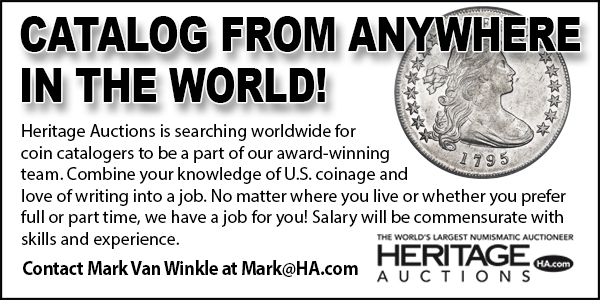
ED MOY'S THOUGHTS ON BITCOIN
 As a medium of exchange, bitcoin offers several unique innovations to currency: global nature, infinite divisibility and easy to carry.
As a medium of exchange, bitcoin offers several unique innovations to currency: global nature, infinite divisibility and easy to carry.
Cryptocurrencies like bitcoin are decentralized and therefore a global medium of exchange. As a truly global currency, it could be used without any need for foreign exchange anywhere in the world. The resulting transactions would be nearly frictionless compared with today’s archaic systems and they would complete immediately.
Bitcoin is also created to be divisible to eight decimal places, with the capability for more in the future. Payments can now be made as small as millionths of a penny. Now the monetization of content becomes much easier. Prices previously too small are now economically viable, allowing many endangered businesses to thrive.
As a store of value, bitcoin offers a unique innovation to currency: it is solely market-based.
Currency’s face value was once redeemable for the same amount in a precious metal. Once governments left the gold standard, the U.S. dollar was made the world’s reserve currency, which was backed by the full faith and credit of the U.S. government. While the U.S. dollar’s value vis-a-vis other currencies is driven by market demand, it is also heavily influenced by central banks’ monetary policy. On the other hand, the market exclusively drives bitcoin’s value. Once bitcoin is more widely adopted, its value will stabilize as it migrates from a speculative investment to a widely accepted medium of exchange.
Cryptocurrencies like bitcoin are decentralized. This means that it is a currency that is not issued by any central authority like a sovereign government. As a result, it is the most profound challenge to governments’ monopoly on creating money.
When all bitcoins have been mined, the total number will be limited to 21 million, which is a natural way to prevent inflation. When sovereign governments’ currencies were no longer redeemable for gold and they could print all they wanted with little accountability, central banks flooded the world with stimulus. With that stimulus comes significant risk, as no country has ever unwound multi-trillion dollar monetary experiments before.
Bitcoin, and the ideas behind it, will be a disrupter to the traditional notions of currency. In the end, currency will be better for it.
To read the complete article, see: THE CURRENCY REVOLUTION, COURTESY OF BITCOIN (edmoy.com/the-currency-revolution-courtesy-of-bitcoin/)
HOW THE HALF PENNY WAS ABOLISHED
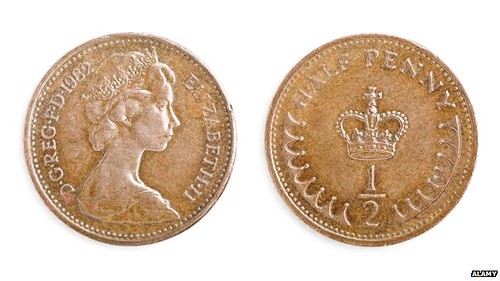
It's 30 years since the British decimal halfpenny was being phased out. Why did the UK hang on to a tiny coin for so long?
Before everyone gets misty-eyed about the bronze halfpenny, it's worth remembering how annoying Britain's least loved coin, notorious for getting lost in trousers and furniture upholstery, was.
People were commonly said not to bother to bend down in the street to pick it up if they dropped one.
"In terms of the coins in your pocket, it's useless," the National Consumer Council told the Herald Tribune in 1983. News stand workers in the early 1980s couldn't even give the unloved halfpenny away, according to the paper. "We've got a bagful in the till, and although customers give them to us in payments sometimes, we can't hand any out," vendor Danny Curbishley complained.
Chancellor Nigel Lawson announced the coin's demise in a written Commons answer in 1984, saying "most people would be glad to get rid of them". The Royal Mint stopped making them at the end of February, and it ceased to be legal tender in December.
But the curious thing about the coin is not that it was abolished, rather that it lasted a full 13 years after its introduction with decimalisation in 1971.
The Treasury's delay in ending the halfpenny arose from fears that if the coin was abolished, retailers would raise prices to the nearest penny, which would in turn contribute to inflation. By 1984, the government had got to a point where it believed so few transactions would be affected, there would be no measurable impact.
The Canadian penny was withdrawn from circulation last year because production costs exceeded its monetary value. There has been a long-running debate in the US over the future of its single cent and the future of the British penny has been questioned.
In 1984, not many people mourned the loss of the halfpenny. "The decimal halfpenny didn't have a long history. It was never top of the bill or had a starring role," says Clancy. But he says to dismiss the coin's value entirely would do it a disservice.
"The halfpenny played an important role in the important transition to a new currency system. It was a point of familiarity. A way of reassuring people things hadn't changed too much," he says.
To read the complete article, see: Halfpenny: The story of how a tiny, 'annoying' coin was abolished (www.bbc.com/news/magazine-27467675)
COPPER PENNY HOARDERS
CHACE: This prospecting for copper - one old penny at a time - there are thousands of people doing this. This is the thing, Steve Wardak is what's known as a coin roll hunter. The coin roll hunters, they like to go online and show off their hauls.
UNIDENTIFIED MAN #1: Well, guys. I did it again. I had to go and pick up another box, $25 worth of penny rolls.
CHACE: There are dozens of these.
UNIDENTIFIED MAN #2: These are all pre-1982 copper pennies. See?
CHACE: Some people have special machines that sort out the pre-1982s out from the post-1982s.
WARDAK: I can turn it on for a second to show you how fast it goes.
(SOUNDBITE OF MACHINERY)
WARDAK: These are all copper...
CHACE: Steve doesn't have a machine 'cause he likes to sort by hand. He gets the coins and he brings them home to his fiancé. And this is kind of the thing they do together at night. They sit next to each other in the living room and go through them.
WARDAK: Just get going. Like, I'll give her a box and I'll take my own box - '82, there's '82.
(SOUNDBITE OF PENNIES)
CHACE: You actually get lucky really quickly. Almost a third of the pennies Steve is pulling out are 1982 or before.
WARDAK: These are the copper pennies. You can tell the difference in sound.
(SOUNDBITE OF COPPER PENNIES)
WARDAK: And these are the zinc pennies that they make now...
(SOUNDBITE OF ZINC PENNIES)
WARDAK: Sounds completely different. It sounds like fake money.
CHACE: Kind of subtle to the untrained ear. Listen for the base. Copper...
(SOUNDBITE OF COPPER PENNIES)
CHACE: Zinc...
(SOUNDBITE OF ZINC PENNIES)
CHACE: Steve has collected $475 in old pennies. He figures the copper is worth double the face value, so that's a thousand dollars, practically, stacked in boxes in the back of his closet.
(SOUNDBITE OF PENNIES)
WARDAK: Eighty two...
CHACE: You know, there is this problem with this investment strategy which is, right now, it is illegal to melt these pennies down. The copper in these pennies is stuck there. Unless - and this is what these guys are hoping for - the U.S. government kills off the penny, then the pennies are no longer U.S. currency. You can scrap them, melt them down.
If you turned on the computer right now and you saw that they'd abolished the penny, what would you do?
(LAUGHTER)
WARDAK: I would probably go buy as many boxes as I could afford.
To listen to the complete story, or read the transcript, see: Penny Hoarders Hope For The Day The Penny Dies (www.npr.org/2014/05/21/314607045/penny-hoarders-hope-for-the-day-the-penny-dies)
CHRISTIE’S SELLS ROCKWELL'S 'COLLECTOR' PAINTING
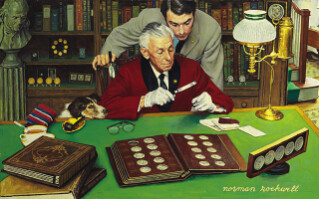
To those who favor traditional, realist painting, Norman Rockwell is the quintessential 20th century American painter.
He’s best known for creating more than 800 magazine covers, most notably for The Saturday Evening Post. His works are among the most expensive American art at auction and over the past several decades he has transcended the illustration art category. Christie’s calls him “perhaps the greatest visual mass communicator of the twentieth century” and his images of American life speak to a global audience today.
In 1970, The Franklin Mint, a private mint founded in 1964 that was active in the production of medals, ingots and various collectibles, commissioned Rockwell to create a series of works to promote the company.
The best-known image from the commission, The Collector, is set to be offered at Christie’s May 22 American Art auction in New York City. The 1971 painting, which measures 30 by 48 inches, carries an estimate of $700,000 to $1 million.
The commission initially called for Rockwell to create drawings that could be made into collectible plates, medals and figures. Rockwell executed 80 sketches between 1970 and 1975 for the project, and The Collector was one of two oil paintings produced as part of the commission.
The image was reproduced in a limited edition series of lithographs for The Franklin Mint Collectors Society. Today, these lithographs are frequently seen in online auctions at the $30 to $50 level.
It is well known that Rockwell worked from photographs and models, yet utilized substantial creative liberties in composing his paintings. For example, a bust of the firm’s namesake, Benjamin Franklin overlooks the scene and Rockwell may have adapted the model bust by Jean-Antoine Houdon to tilt downward.
To read the complete article, see: Norman Rockwell 1971 painting 'The Collector' set for May 22 Christie's auction in New York City (/www.coinworld.com/insights/Rockwells-The-Collector-captures-hobby-scene.html)
To read the complete auction lot description, see:
NORMAN ROCKWELL (1894-1978)
THE COLLECTOR
(www.christies.com/lotfinder/paintings/norman-rockwell
-the-collector-5793592-details.aspx)
FEATURED WEB PAGE: ISAAC NEWTON'S MINT REPORTS
This week's Featured Web Page is a collection of Isaac Newton's Royal Mint reports from 1701 to 1725.Of these official reports only three have hitherto appeared in print. In the following pages, however, I have reprinted from the original copies in the Treasury Board Papers at the Record Office all these papers which distinctly bear on coinage or exchange matters.
The papers are mostly in Newton's own hand; and as being the copies actually forwarded as reports to the Treasury, must be regarded as the most final and authentic form of the documents he drafted. On the other hand, it is quite apparent that the Treasury Board Papers do not now contain many reports and papers of Newton on mint, coinage, and exchange affairs, which he drew up during his official career.

www.pierre-marteau.com/editions/
1701-25-mint-reports.html
